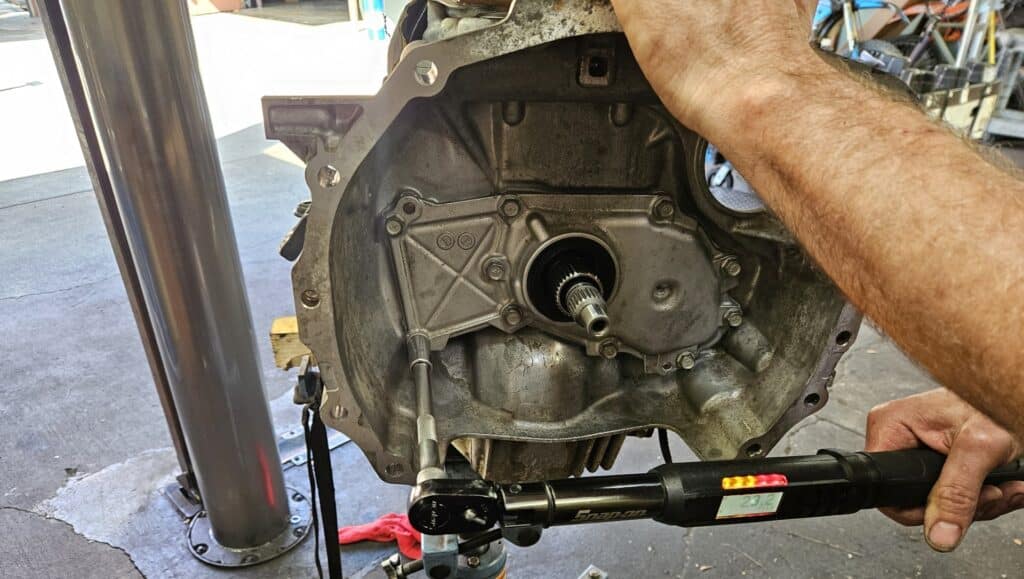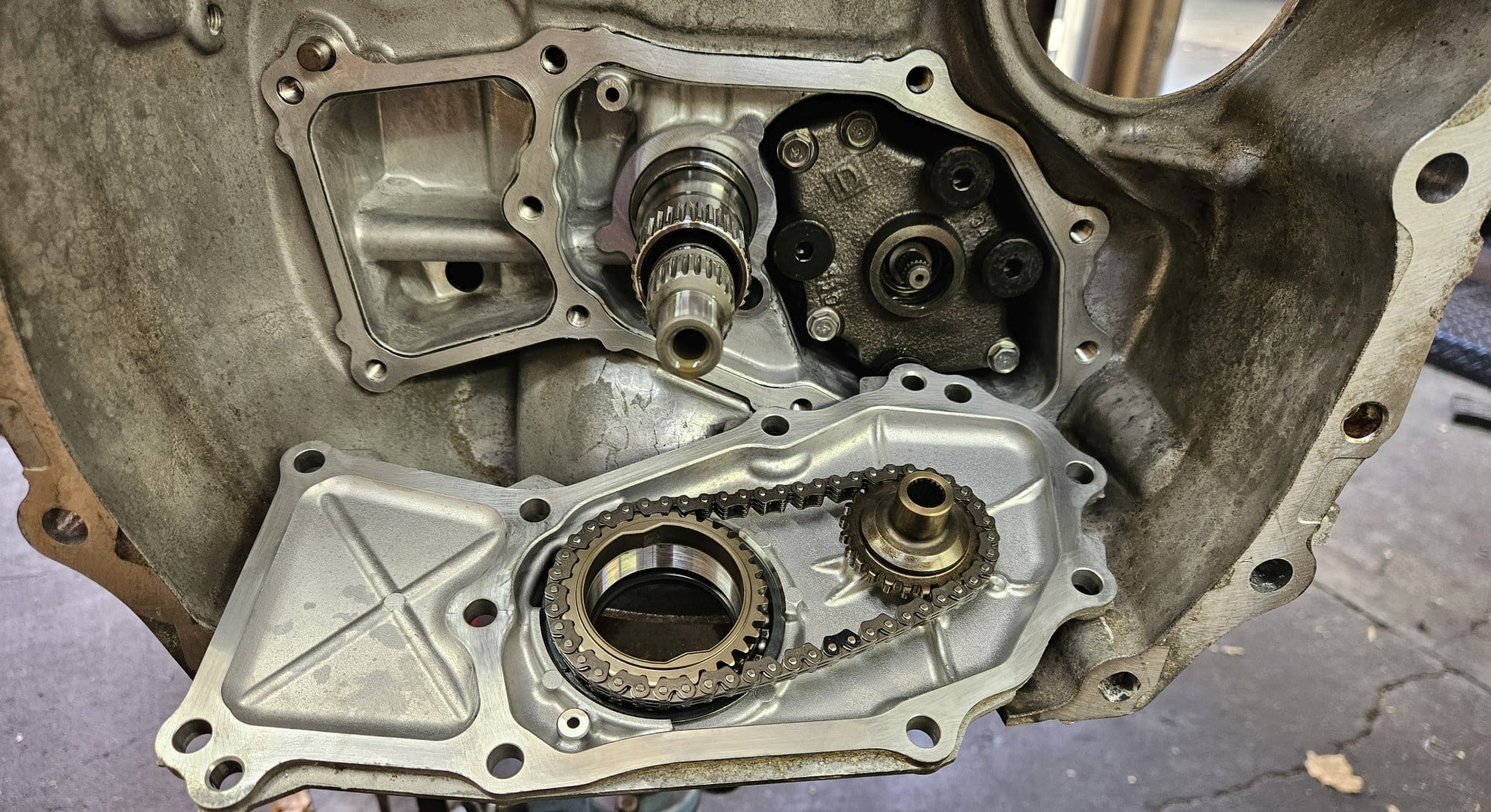This page explains the Subaru CVT transmission oil pump chain cover leak repair common to several years and models of Subaru with TR580 and TR690 CVT transmissions. The leak appears as drips and oily residue that appears on the bottom of the transmission and from the torque converter case. The list of affected models is below, so if your car is on the list and you’re noticing that your Subaru is leaking CVT transmission fluid, you may find this article useful.
Affected Subaru years / models
- 2019-2019 Legacy and Outback
- 2014-2019 Forester
- 2012-2019 Impreza
- 2013-2019 Crosstrek
- 2015-2019 WRX
- 2019-2020 Ascent
Is this CVT leak chain cover leak repair covered by Subaru warranty?
This might be covered under warranty, even if you’re out of your basic warranty period. In 2017 Subaru extended the warranty on some CVT transmission to 10 years or 100K miles. You can find the details in TSB 16-107-17R. The torque converter seal and the oil pump seal are covered items, and as far as I can tell the sealant on the oil pump chain cover is the only thing sealing the oil pump, so I believe that it should be covered. So, if your Subaru has a CVT transmission leak and you have less that 10 years / 100K, call your local dealership and ask if it would be covered.
A quick note. The dealer can tell you if an item would be covered as a hypothetical over the phone. You don’t need to pay $250 for them to lift the car and look at it for them to tell you if something would be covered if it were found to be bad. However, you will almost certainly need to pay a diagnostic fee for them to verify the source of the leak and start the warranty claim.
Where is the CVT leak coming from?
Usually, you’ll notice drips hanging from the joint between the engine and the transmission, but because of gravity and wind, there are also often drips on the bottom of the transmission case. The leak is coming from the oil pump chain cover that bolts to the front of the transmission case behind the torque converter.
Does this leak need to be repaired?
Can you just ignore this leak? Is it really necessary to fix it? As with all oil leaks (and all auto repair decisions), it depends on how you feel about it. In the end, it’s your decision, but here are the factors to consider when making your decision.
Is it leaving a mess where you park?
If you’re parking on the street this may not be an issue for you. A little CVT fluid on the ground may absorb right into the asphalt. If on the other hand you park in a garage, this may not be acceptable for you (or the landlord).
Is the fluid getting on anything else and causing additional problems?
If you get transmission fluid on rubber bushings the bushings can swell and become damaged. The transmission fluid gets on the exhaust thick and smoke and create a foul odor. Typically, this Subaru CVT it does not cause either of these issues.
Can you add fluid frequently enough from getting low and damaging the transmission?
If you can keep your CVT fluid full, you could conceivably continue driving forever and never fix this issue, provided you don’t mind the drips under the car. However, this is easier said than done. Some automotive oils and fluids like motor oil or power steering fluid are easily checked and added. This is not the case with CVT fluid.
Checking the CVT fluid level requires a Subaru Select Monitor factory scan tool or an OE level aftermarket equivalent. This is because the fluid level is set at a particular temperature. Transmission fluid must be between 95°f and 113°f when the level is checked.
Also, there is no dipstick on these Subaru CVTs. They use a level plug/port, which must be accessed from underneath the car, so you’ll need some way to raise the car (while level) to gain access.
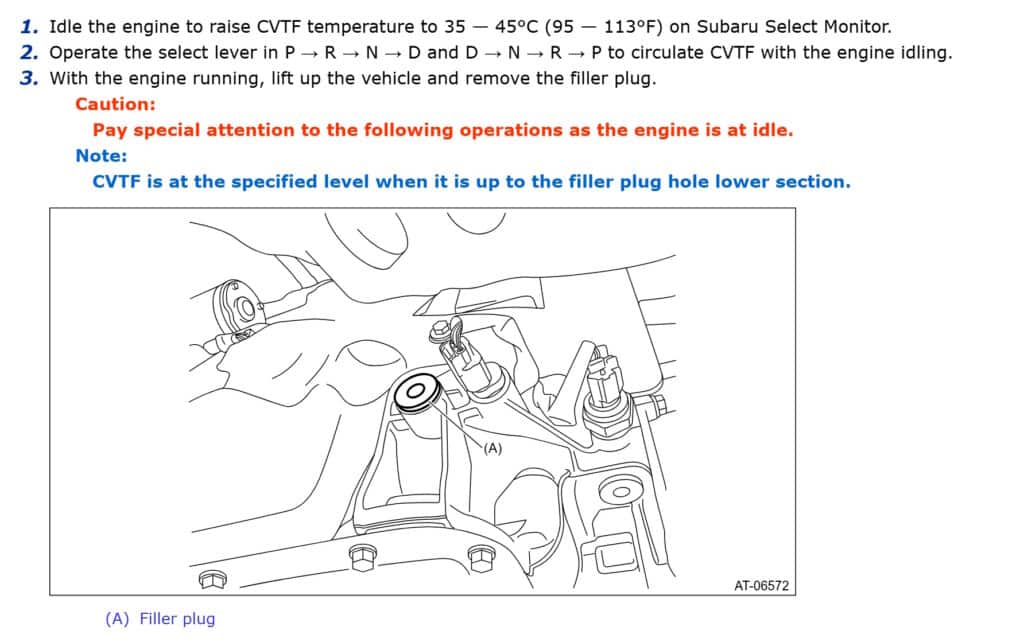
How much does it cost to repair this leak?
For most of the vehicles with this issue the total labor is 8 hours, which at the time of this writing is $176/hour, so about $1400 in labor. The parts are fairly cheap. They’re a round $300 currently, the CVT fluid being the bulk of the parts cost.
Why so much labor? The transmission and torque converter must be removed to remove the oil pump chain cover plate and that takes time. Unfortunately, this can’t be fixed with the transmission in the car.
How long does this repair take?
We may complete this repair in a single day if parts are ordered ahead of your appointment. However, the time it takes to complete the repair is very close the length of our workday, so it’s possible it won’t be done on the same day. You should plan to be without your car for two days.
How long will the repair last?
Usually, cases and covers sealed with FIPG (form in place gasket) don’t develop leaks. Usually when something like this happens it’s due to a manufacturing process error. Since the machined surfaces have been perfect on every CVT we’ve seen so far, I’d guess the issue was either cleanliness of the surfaces prior to FIPG application, a problem with the application (too little applied or similar), or an issue with the type or production of the FIPG used.
Regardless, we take pride in our surface preparation and application of sealant. We remove all traces of the old sealant, carefully apply new sealant (the Threebond 1215 specified in TSB 16-103-16R), and assemble the parts carefully to avoid disturbing the sealant.
How is the repair performed?
These are a few images from a 2014 Subaru XV Crosstrek with a TR580 CVT transmission we had in the shop today. It isn’t one of the worst we’ve seen, but there were drips hanging on the bottom of the transmission, so it was worth fixing.
Step 1: Remove the transmission
There’s no way to get to the CVT oil pump cover without removing the transmission or engine, since it sits in between the two.
It makes far more sense to remove the transmission, because it’s much easier to work with the transmission out in the open.
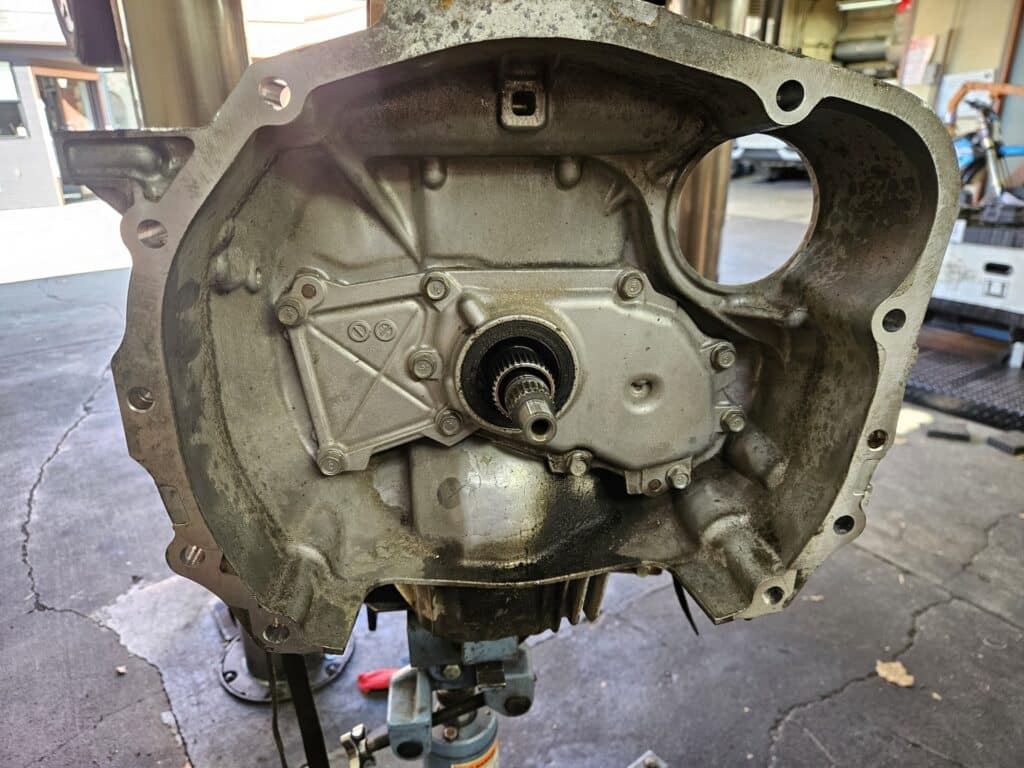
Step 2: Remove the cover
After removing the perimeter bolts on the cover, you can see the stator splines and input shaft splines as well as the oil pump.
An interesting note if you plan to test the oil pump pressure on one of these units. The normal range at idle with a warm engine is about 72 PSI to 220 PSI, but if you plan to test it, be sure to grab a gauge that can handle much more pressure because when cold the pressure will MUCH higher.
We found this out when we destroyed a 350 PSI gauge measuring what must have been over 400 PSI with a cold transmission at idle.
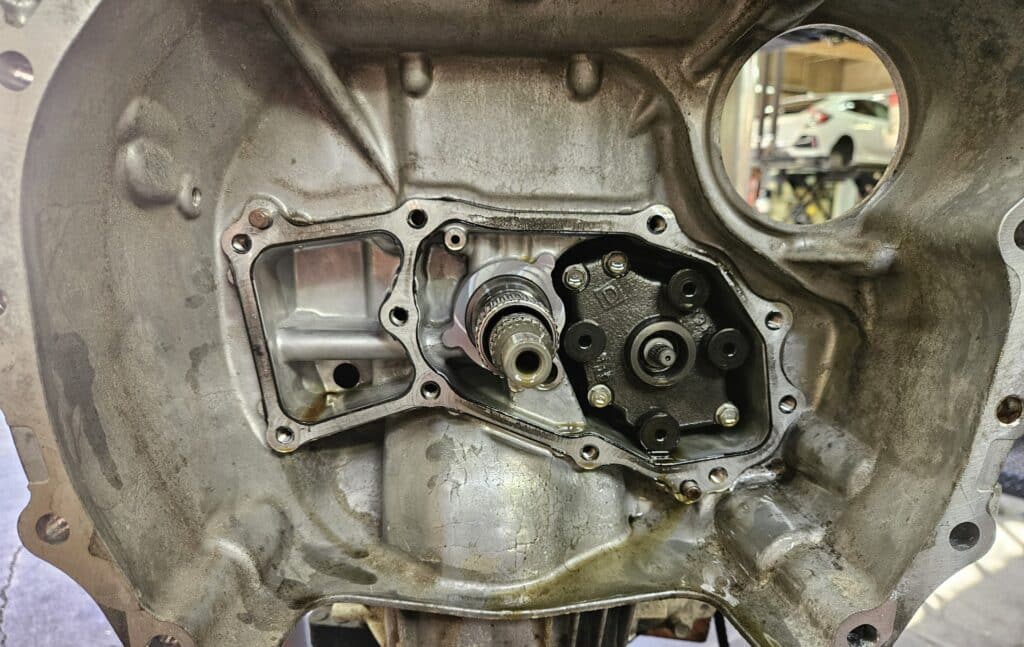
Step 3: Inspection
It’s always a good idea to take a careful look at your parts when you’re doing your cleaning. This is a great time to make sure that you have all the parts you need and that there there’s no damage that might cause an issue as you’re going back together.
Paying attention at this stage helps prevent comebacks.
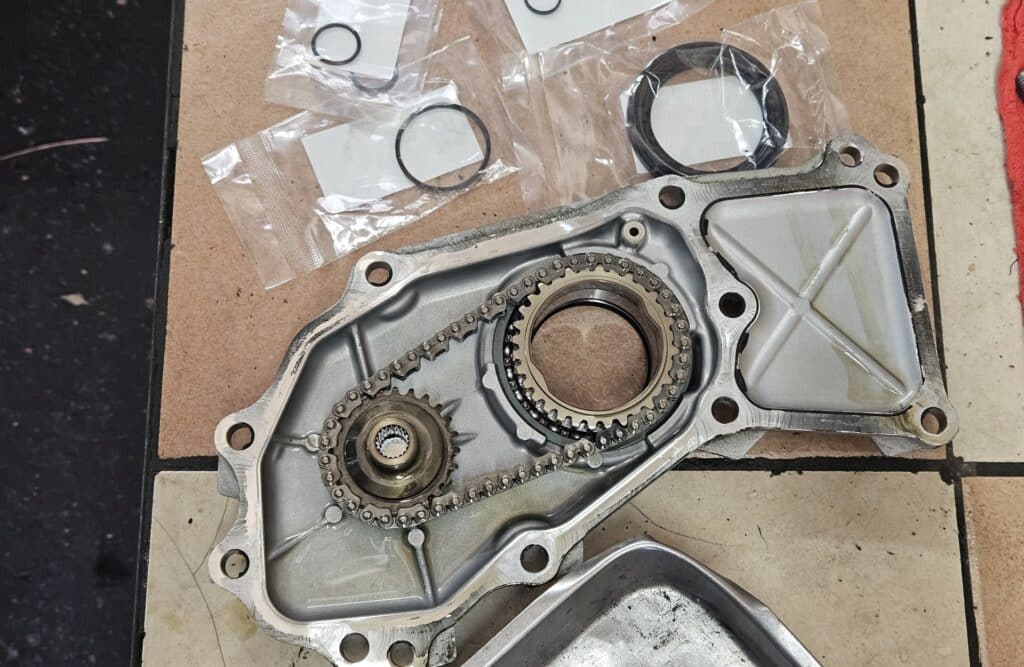
Step 4: Thorough cleaning
I suspect that lack of cleanliness was the cause of the original fault on so many of these vehicles, so we feel spending some time doing a thorough cleaning job is very important.
This means removing all of the old sealant and any grease on the sealing surfaces, including fingerprints. We use heptane to wipe the surfaces immediately before applying sealant and then we’re very sure that no oil dribbles and the sealing surfaces are not touched at all before assembly.
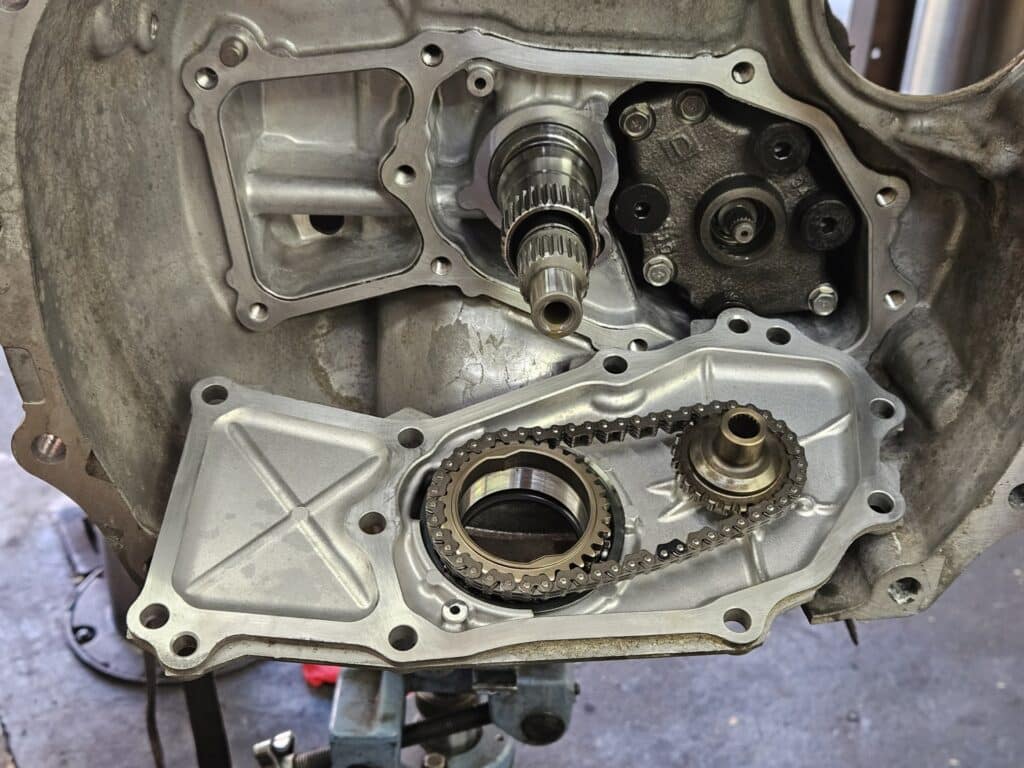
Step 5: Apply sealant
The original sealant used at the factory was a black form replace gasket of some sort. Subaru currently specifies Threebond 1215 so that’s what we use.
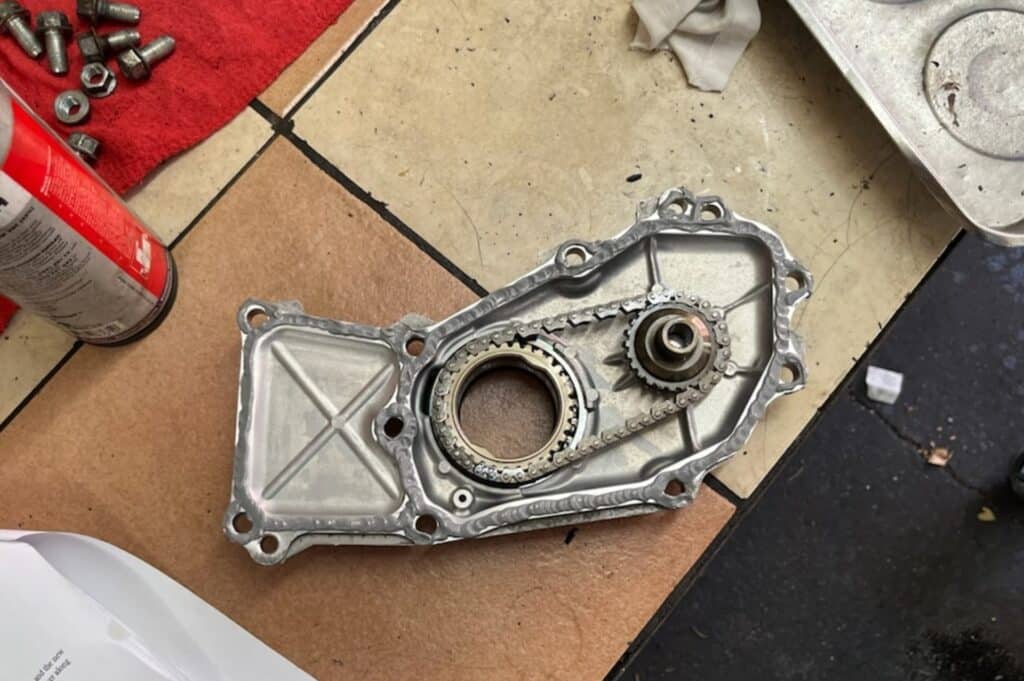
Step 6: Torque the cover
Final step is to torque the bolts that hold the cover to the transmission.
Using a torque wrench to snug oil pump chain cover bolts.
As you can see, resealing the cover is actually a pretty quick job. If it were not for the fact that we had to remove and replace the transmission it would probably take less than an hour.
